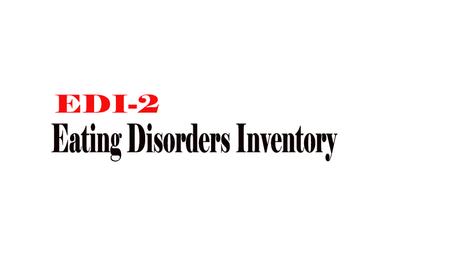
Brief Description:
* Garner (1991)* Three versions: EDI developed by Garner and Olmsted in 1984. EDI-2 released by Psychological Assessment Resources Inc. in 1991, and the EDI-3 released in 2009 (few published studies on it at the present time).* Widely used in diagnosis of anorexia, bulimia and eating disorders not otherwise specified (EDNOS)* Made up of 11 scales assessing behaviour, symptoms and personality traits of those with eating disorders: Drive for thinness, Bulimia, Body dissatisfaction, Ineffectiveness, Perfectionism, Interpersonal distrust, Interceptive awareness, Maturity fears, Asceticism, Impulse regulation, and Social insecurity.
Type of Measure:
* Self-report
* Ninety-one items (originally 64)
* Six point Likert scale
* Takes around 20 minutes to complete
Target Population:
* Adults
* Females
Scoring:
* Responses are coded into four categories from zero to three. Zero is assigned to those answers farther away from the "symptomatic" direction.
Psychometrics:Source Reference: Tasca et al., (2003): 144 outpatient females with Binge Eating Disorder (BED) and 152 outpatients with Bulimia Nervosa (BN).
* Reliability: Cronbach's alpha = ranged from 0.56 to 0.90 for the BED sample and 0.55 to 0.91 (BN) sample; Inter-item reliability ranged from r = 0.13 to 0.48 for the BED sample and r = 0.12 to 0.52 for the BN sample
* Validity: Test-retest after 16 weeks ranged from r = 0.67 to 0.82; Positive correlations were found between subscales of theEDI-2 and the EDEQ (Eating Disorders Examination Questionnaire) and PAI (Personality Assessment Inventory)
* Two factor model
Nevonen, Clinton, & Norring, 2006: 978 patients with eating disorders, 106 outpatients and 602 normal controls; Swedish
* Reliability: Cronbach's alpha across participants ranged from 0.62 to 0.90 (with the exception of Asceticism in normal control group: 0.43)
* Validity: Scales differ between patient and control groups
Ebrenz, & Gleavs (1994): 300 women seeking treatment for eating disorders at the Renfrew Center in Philadelphia and Florida
* Reliability: Cronbach's alpha ranged from 0.65 to 0.91 across scales
* Validity: Inter-item correlations ranged from 0.22 (with the exception of one at 0.02) to 0.82 across scales
* Eight factor model
Utility for Prevalence Surveys:
* Poor
Research Applicability:
* Widely used
Copyright, Cost and Source Issues:
* At cost
Originals:
EDI
Garner, D. M., & Olmsted, M. P. (1984). The Eating Disorder Inventory manual. Odessa, FL: Psychological Assessment Resources.
EDI-2
Garner, D. M. (1991). Eating Disorder Inventory-2 professional manual. Odessa, FL: Psychological Assessment Resources.
Source References:
Tasca, G.A., Illing, V., Lybanon-Daigle, V., Bissada, H., & Balfour, L. (2003). Psychometric properties of the eating disorders inventory-2 among women seeking treatment for binge eating disorder. Assessment, 10(3), 228-236.
Supporting References:
Eberenz, K. P., & Gleaves, D. H. (1994). An examination of the internal consistency and factor structure of the Eating Disorder Inventory-2 in a clinical sample. International Journal of Eating Disorders, 16(4), 371-379.
Podar, I., & Allik, J. (2009). A cross-cultural comparison of the Eating Disorder Inventory. International Journal of Eating Disorders, 42(4), 346-355.
Nevonen, L., Clinton, D., & Norring, C. (2006). Validating the EDI-2 in three Swedish female samples: Eating disorders patients, psychiatric outpatients and normal controls. Nord J Psychiatry, 60(1), 44-50.
Strengths:
* Very widely used
Weaknesses:
* Combination of negative and positively keyed words use in the questions.
* Lengthy for use in prevalence surveys, although some investigators use selected subscales.

